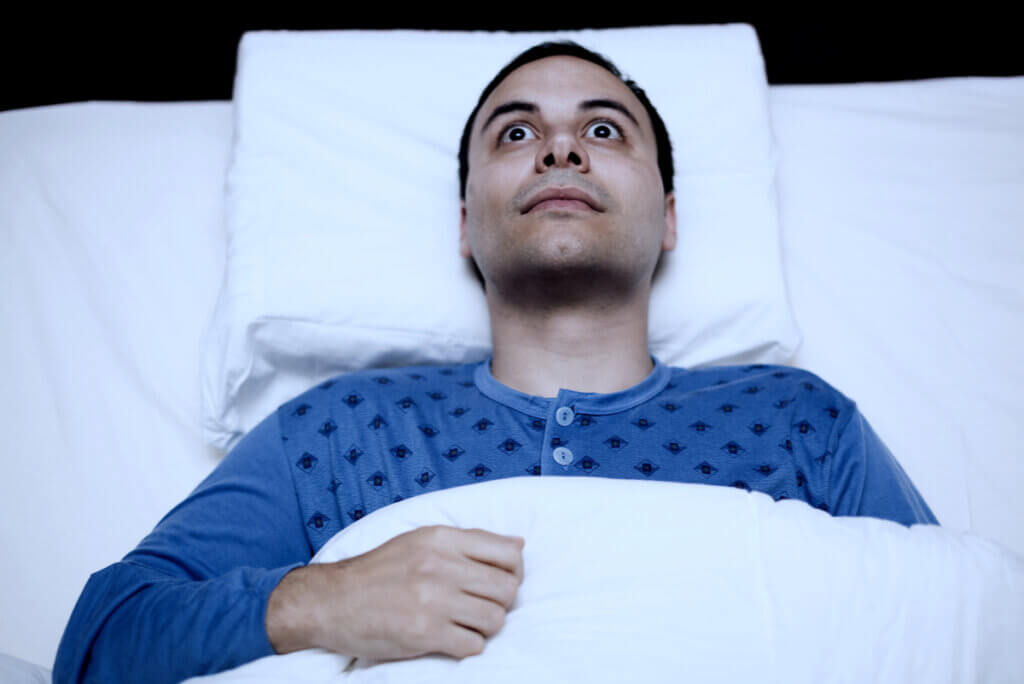Chronic Anxiety: What Is It?


Escrito y verificado por la psicóloga Leticia Aguilar Iborra
Constant palpitations in the chest, a feeling of suffocation, and worries about the future are three of the multiple symptoms that can be felt within the experience of chronic anxiety. Anxiety is a normal response of the body to a dangerous situation. This response helps prepare the organism to carry out a concrete action that favors survival through avoidance or confrontation. However, chronic anxiety can occur when the reasons for experiencing it aren’t clear.
In other words, these symptoms can be experienced in the absence of environmental stimuli that produce them. Concerns exist around areas such as health, the economy, family, work, and social relationships.
The characteristics of chronic anxiety
Anxiety is a state by which the individual prepares for action against something negative. This preparation is precipitated by concerns about the future and its possible consequences.
Anxiety is associated with a negative emotional tone, overactivation of the body, and feelings of unpredictability and lack of control. In addition, there’s excessively focused attention on the stimulus that’s related to the threat.
In chronic anxiety, the stimulus related to the threat can vary, changing the main focus of the worry without having an associated external stimulus. Sometimes anxiety-provoking stimuli are memories, thoughts, and images that the person views as real and threatening.
The problem is that, faced with attempts to control the situation to reduce anxiety, the person can fall into the anxiety loop: The more attempts they make to reduce it, the greater their frustration at not being under their control. As a consequence, the feeling of lack of control and the unpleasant symptoms of chronic anxiety increase.

Avoid fear at all costs
The problem of people suffering from chronic anxiety isn’t the fear of future events that are seen as absolute realities. The real problem is that they often feel overwhelmed by the demands they place on themselves to experience these unpleasant sensations.
In short, the lives of chronically anxious individuals are focused on not experiencing anxiety or fear. Unpleasant memories about the past and worries tend to be avoided so that the symptoms don’t appear.
Living with anxiety means avoiding other actions that might initially be pleasurable. For example, putting activities related to the work environment before a gathering with friends, the use of substances to control symptoms, avoiding visiting open spaces. This translates into a reduction in pleasurable activities and a limitation in the person’s life.
Anxiety and fear become problematic for the following reasons:
- The person isn’t willing to experience anxiety and fear.
- Action is taken to avoid unpleasant symptoms caused by anxiety. These signs can range from physical sensations to negative emotions, thoughts, images, or memories.
- Important areas of life are lost in order to reduce anxiety, which implies a departure from values.
Clinical experience has shown that, ironically, it’s often the patient’s attempts to solve their problem that in fact maintain it. The attempted solution becomes the real problem.
Giorgio Nardone and Paul Watzlawick
Emotional maladjustment in chronic anxiety
People with chronic anxiety disorder don’t experience feelings of fear and anxiety as normal, but as negative emotional events that must be controlled at all costs. Avoidance strategies are usually very subtle and aren’t always noticeable from the outside.
A clear example can be cognitive control strategies, in which the details of a conversation that led to a disagreement are mentally reviewed. The person maintains a dialogue with themself about their concern and possible alternative solutions.
Emotional regulation efforts work only up to a point. Being effective in the short term, people with anxiety often use these types of strategies.
However, in the long term, they end up being the factor that causes the problem to persist. In fact, these unpleasant sensations may even increase by coming into full contact with anxiety, withdrawing from activities that may be important. One of the clear examples can be phrases like “To be a good parent I first have to control my anxiety. If not, I won’t enjoy time with my child.”
Psychological therapy for anxiety
There’s a wide variety of treatments for chronic anxiety, and medication can even be used in the most severe cases. The latter is possible, as long as it’s recommended by a professional. However, the main psychological treatments will be discussed here.
Cognitive behavioral therapy (CBT)
Cognitive behavioral therapy (CBT) is the first-line treatment for many professionals due to its success. CBT considers anxiety to be a learned or acquired behavior through classical and operant conditioning processes, maintained by avoidance or escape responses.
Therefore, the person is encouraged to face the stimuli and situations that generate anxiety within a safe therapeutic context. This allows acquiring new learning that doesn’t involve avoidance responses. Some of the techniques used may be exercises focused on abdominal breathing, progressive muscle relaxation, or exposure with response prevention.
In CBT therapy, not only behavioral strategies are used, but also techniques focused on cognition. Examples of this type might be cognitive restructuring, guided imagery, and exposure to worry.

Contextual therapies: Third-generation therapies
Unlike CBT, contextual therapies don’t involve change that involves changing irrational thoughts or beliefs. Rather, the goal of third-generation therapies is to make the person distance themselves from anxiety-provoking thoughts.
Specifically, Acceptance and Commitment Therapy (ACT) tends to focus on areas of human life that go beyond short-term symptom relief. ACT is based on a model that, through experiential exercises, promotes the acceptance of discomfort when nothing can be changed.
In addition, it favors behavioral change processes when the person is very focused on symptom control, forgetting other important areas in their life. Third-generation therapies use other techniques, such as mindfulness, favoring full attention and contact with the experience in the present moment.
Alternatives in chronic anxiety
In short, both cognitive behavioral techniques and third-generation therapies have been effective in the treatment of chronic anxiety and other types of anxiety. The long-term effectiveness of the treatment is usually satisfactory, and the person can recover areas of their life that had been forgotten.
In addition to psychological treatment in the therapeutic context, there are other activities that can be carried out to channel unpleasant sensations. An example of this can be physical exercise and other types of activities that mean abandoning the fight with the discomfort caused by worries.
Constant palpitations in the chest, a feeling of suffocation, and worries about the future are three of the multiple symptoms that can be felt within the experience of chronic anxiety. Anxiety is a normal response of the body to a dangerous situation. This response helps prepare the organism to carry out a concrete action that favors survival through avoidance or confrontation. However, chronic anxiety can occur when the reasons for experiencing it aren’t clear.
In other words, these symptoms can be experienced in the absence of environmental stimuli that produce them. Concerns exist around areas such as health, the economy, family, work, and social relationships.
The characteristics of chronic anxiety
Anxiety is a state by which the individual prepares for action against something negative. This preparation is precipitated by concerns about the future and its possible consequences.
Anxiety is associated with a negative emotional tone, overactivation of the body, and feelings of unpredictability and lack of control. In addition, there’s excessively focused attention on the stimulus that’s related to the threat.
In chronic anxiety, the stimulus related to the threat can vary, changing the main focus of the worry without having an associated external stimulus. Sometimes anxiety-provoking stimuli are memories, thoughts, and images that the person views as real and threatening.
The problem is that, faced with attempts to control the situation to reduce anxiety, the person can fall into the anxiety loop: The more attempts they make to reduce it, the greater their frustration at not being under their control. As a consequence, the feeling of lack of control and the unpleasant symptoms of chronic anxiety increase.

Avoid fear at all costs
The problem of people suffering from chronic anxiety isn’t the fear of future events that are seen as absolute realities. The real problem is that they often feel overwhelmed by the demands they place on themselves to experience these unpleasant sensations.
In short, the lives of chronically anxious individuals are focused on not experiencing anxiety or fear. Unpleasant memories about the past and worries tend to be avoided so that the symptoms don’t appear.
Living with anxiety means avoiding other actions that might initially be pleasurable. For example, putting activities related to the work environment before a gathering with friends, the use of substances to control symptoms, avoiding visiting open spaces. This translates into a reduction in pleasurable activities and a limitation in the person’s life.
Anxiety and fear become problematic for the following reasons:
- The person isn’t willing to experience anxiety and fear.
- Action is taken to avoid unpleasant symptoms caused by anxiety. These signs can range from physical sensations to negative emotions, thoughts, images, or memories.
- Important areas of life are lost in order to reduce anxiety, which implies a departure from values.
Clinical experience has shown that, ironically, it’s often the patient’s attempts to solve their problem that in fact maintain it. The attempted solution becomes the real problem.
Giorgio Nardone and Paul Watzlawick
Emotional maladjustment in chronic anxiety
People with chronic anxiety disorder don’t experience feelings of fear and anxiety as normal, but as negative emotional events that must be controlled at all costs. Avoidance strategies are usually very subtle and aren’t always noticeable from the outside.
A clear example can be cognitive control strategies, in which the details of a conversation that led to a disagreement are mentally reviewed. The person maintains a dialogue with themself about their concern and possible alternative solutions.
Emotional regulation efforts work only up to a point. Being effective in the short term, people with anxiety often use these types of strategies.
However, in the long term, they end up being the factor that causes the problem to persist. In fact, these unpleasant sensations may even increase by coming into full contact with anxiety, withdrawing from activities that may be important. One of the clear examples can be phrases like “To be a good parent I first have to control my anxiety. If not, I won’t enjoy time with my child.”
Psychological therapy for anxiety
There’s a wide variety of treatments for chronic anxiety, and medication can even be used in the most severe cases. The latter is possible, as long as it’s recommended by a professional. However, the main psychological treatments will be discussed here.
Cognitive behavioral therapy (CBT)
Cognitive behavioral therapy (CBT) is the first-line treatment for many professionals due to its success. CBT considers anxiety to be a learned or acquired behavior through classical and operant conditioning processes, maintained by avoidance or escape responses.
Therefore, the person is encouraged to face the stimuli and situations that generate anxiety within a safe therapeutic context. This allows acquiring new learning that doesn’t involve avoidance responses. Some of the techniques used may be exercises focused on abdominal breathing, progressive muscle relaxation, or exposure with response prevention.
In CBT therapy, not only behavioral strategies are used, but also techniques focused on cognition. Examples of this type might be cognitive restructuring, guided imagery, and exposure to worry.

Contextual therapies: Third-generation therapies
Unlike CBT, contextual therapies don’t involve change that involves changing irrational thoughts or beliefs. Rather, the goal of third-generation therapies is to make the person distance themselves from anxiety-provoking thoughts.
Specifically, Acceptance and Commitment Therapy (ACT) tends to focus on areas of human life that go beyond short-term symptom relief. ACT is based on a model that, through experiential exercises, promotes the acceptance of discomfort when nothing can be changed.
In addition, it favors behavioral change processes when the person is very focused on symptom control, forgetting other important areas in their life. Third-generation therapies use other techniques, such as mindfulness, favoring full attention and contact with the experience in the present moment.
Alternatives in chronic anxiety
In short, both cognitive behavioral techniques and third-generation therapies have been effective in the treatment of chronic anxiety and other types of anxiety. The long-term effectiveness of the treatment is usually satisfactory, and the person can recover areas of their life that had been forgotten.
In addition to psychological treatment in the therapeutic context, there are other activities that can be carried out to channel unpleasant sensations. An example of this can be physical exercise and other types of activities that mean abandoning the fight with the discomfort caused by worries.
- Eifert, G.H. & Forsyth, J.P.(2019). La Terapia de Aceptación y Compromiso para los Trastornos de Ansiedad. Mensajero: Madrid.
- Orozco, Wendy Navas, and María Jesús Vargas Baldares. “Trastornos de ansiedad: revisión dirigida para atención primaria.” Revista médica de costa rica y Centroamérica 69.604 (2012): 497-507.
- Fernández, María Ángeles Ruiz, MARTA ISABEL DíAZ GARCíA, and Arabella Villalobos Crespo. Manual de técnicas de intervención cognitivo conductuales. Desclée de Brouwer, 2012.
Este texto se ofrece únicamente con propósitos informativos y no reemplaza la consulta con un profesional. Ante dudas, consulta a tu especialista.







